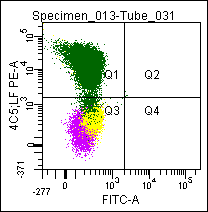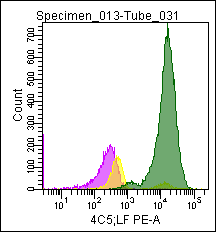Catalogue

Mouse anti Lactoferrin, conjugated to PE
Catalog number: GM-4113| Clone | 4C5 |
| Isotype | IgG1 |
| Product Type |
Primary Antibodies |
| Units | 2ml (100 Tests) |
| Host | Mouse |
| Species Reactivity |
Human |
| Application |
Flow Cytometry Immunofluoresence |
Background
Lactoferrin (LF) is an iron-binding protein with bactericidal and bacteriostatic activity, which is stored within the secondary granules of granulocytes. LF expression is restricted to the post-mitotic maturation compartment of the granulocytic lineage, starting from the myelocyte stage. Normal and malignant myeloblasts are LF negative.
The 4C5 antibody permits the identification and enumeration of human granulocytes using flow cytometry. Results must be interpreted by a certified professional before final interpretation. Analyses performed with this antibody should be paralleled by positive and negative controls. If unexpected results are obtained which cannot be attributed to differences in laboratory procedures, please contact us.
Product
2 ml of PE-conjugated anti Lactoferrin (clone 4C5) in PBS pH 7.2, 1% BSA, and 0.05% NaN3, approximately 100 tests.
Product Form: PE
Formulation: PBS pH 7.2, 1% BSA, 0.05% NaN3
Purification Method: Purified by Chromatography
Specificity
The LF mAb (clone 4C5) recognizes Lactoferrin stored within secondary granules of postmitotic granulocyte-committed cells.
The sensitivity of 4C5 mAb is determined by staining well-defined blood samples from representative donors with serial-fold mAb dilutions to obtain a titration curve that allows relating the mAb concentration to the percentage of stained cells and geometric MFI (mean fluorescence intensity). For this purpose, a mAb concentration range is selected to include both the saturation point (i.e. the mAb dilution expected to bind all epitopes on the target cell) and the detection threshold (i.e. the mAb dilution expected to represent the least amount of mAb needed to detect an identical percentage of cells). In practice, 50 µl of leukocytes containing 10^7
cells/ml are stained with 20 µl mAb of various dilutions to obtain a titration curve and to identify the saturation point and detection threshold. The final concentration of the product is then adjusted to be at least 3-fold above the detection threshold. In addition and to control lot-to-lot variation, the given lot is compared and adjusted to fluorescence standards with defined intensity.
Applications
Permeabilization and Staining Procedure
- In combination with our Permeabilization Kit FIX&PERM® (Cat. NoGAS-002) intracellular Lactoferrin can be easily stained in cell suspensions.
- For each sample to be analyzed add 50 µl of whole blood, bone marrow or mononuclear cell suspension in a 5ml tube
- Add 100 µl of Reagent A (Fixation Medium, stored and used at room temperature)
- Incubate for 15 minutes at room temperature
- Add 5ml phosphate buffered saline and centrifuge cells for 5 minutes at 300 g
- Remove supernatant and add to cell pellet 100 µl Reagent B (Permeabilization Medium) and 20 µl of the Lactoferrin monoclonal antibody conjugate
- Vortex at low speed for 1-2 seconds
- Incubate for 15 minutes at room temperature
- Wash cells with phosphate buffered saline as described above
- Remove supernatant and resuspend cells in sheath fluid for immediate analysis or resuspend cells in 0.5 ml 1.0 % formaldehyde and store them at 2-8°C in the dark. Analyze fixed
cells within 24 hours.
Conventional Staining for Microscopic Evaluations
LF-Antibody 4C5 can also be used to demonstrate lactoferrin molecules by conventional immunofluorescence or immunoenzyme staining techniques on cell smears, cytospin
preparations or tissue sections. Acetone or paraformaldehyde are suitable fixatives for these purposes.
Storage
Nordic-MUbio monoclonal antibody reagents contain optimal concentrations of affinity-purified antibody. For stability reasons this monoclonal antibody solution contains sodium azide. These reagents should be stored at 2-8°C (DO NOT FREEZE!) and protected from prolonged exposure to light. If a slight precipitation occurs upon storage, this should be removed by centrifugation. It will not affect the performance or the concentration of the product. Stability of the reagent: Please refer to the expiry date printed onto the vial. The use of the reagent after the expiration date is not recommended.
Caution
This product is intended FOR RESEARCH USE ONLY, and FOR TESTS IN VITRO, not for use in diagnostic or therapeutic procedures involving humans or animals. It may contain hazardous ingredients. Please refer to the Safety Data Sheets (SDS) for additional information and proper handling procedures. Dispose product remainders according to local regulations.This datasheet is as accurate as reasonably achievable, but Nordic-MUbio accepts no liability for any inaccuracies or omissions in this information.
References
1. Braylan, R. C., Orfao, A., Borowitz, M. J. & Davis, B. H. (2001) Cytometry 46, 23-7.
2.
Catovsky, D., Matutes, E., Buccheri, V., Shetty, V., Hanslip, J., Yoshida, N. & Morilla, R. (1991) Ann Hematol 62, 16-21.
3. Cowland, J. B. & Borregaard, N. (1999) J Leukoc Biol 66, 989-95
4.
Cramer, E., Pryzwansky, K. B., Villeval, J. L., Testa, U. & Breton-Gorius, J. (1985) Blood 65, 423-32.
5. Groeneveld, K., te Marvelde, J. G., van den Beemd, M. WHooijkaas, H. & van Dongen, J. J. (1996) Leukemia 10, 1383-9.
6.
Gullberg, U., Andersson, E., Garwicz, D., Lindmark, A. & Olsson, I. (1997) Eur J Haematol 58, 137-53.
7. He, J. & Furmanski, P. (1995) Nature 373, 721-4
8. Knapp, W., Majdic, O. & Strobl, H. (1993) Recent Results Cancer Res 131, 31-40.
9.
Konikova, E., Glasova, M., Kusenda, J. & Babusikova, O. (1998) Neoplasma 45, 282-91.
10.
Oehler, L., Majdic, O., Pickl, W. F., Stockl, J., Riedl, E., Drach, J., Rappersberger, K., Geissler, K. & Knapp, W. (1998) J Exp Med 187, 1019-28.
11.
Paietta, E. (2003) Best Pract Res Clin Haematol 16, 671-83.
12. Rado, T. A., Bollekens, J., St Laurent, G., Parker, L. & Benz, E. J., Jr. (1984) Blood 64, 1103-9.
13. Rado, T. A., Wei, X. P. & Benz, E. J., Jr. (1987) Blood 70, 989-93.
14. Srivastava, C. H., Rado, T. A., Bauerle, D. & Broxmeyer, H. E. (1991) J Immunol 146, 1014-9.
15. Strobl, H. & Knapp, W. (2004) J Biol Regul Homeost Agents 18, 335-9.
16.
Teng, C. T., Gladwell, W., Beard, C., Walmer, D., Teng, C. S. & Brenner, R. (2002) Mol Hum Reprod 8, 58-67.
Warranty
The products sold hereunder are warranted only to conform to the quantity and contents stated on the label at the time of delivery to the customer. There are no warranties, expressed or implied, that extend beyond the description on the label of the product. Nordic-MUbio`s sole liability is limited to either replacement of the products or refund of the purchase price. Nordic-MUbio is not liable for property damage, personal injury, or economic loss caused by the product.
Safety Datasheet(s) for this product:
| NM_Sodium Azide |

Figure 1. Flow cytometric analysis of a normal blood sample after immunostaining with GM-4113 (MPO-C2-PE)

Figure 2. Flow cytometric analysis of a normal blood sample after immunostaining with GM-4192 (MPO-C2-PE)


